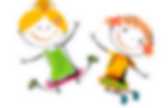

Learning in a Reggio Inspired Kindergarten Environment: Flow of the Day in FDK. Learn With Us. Insights from Dr.

Lilian Katz Dr. TeachingMadeEasy: Meaningful observations: Examples of documented observations. To move beyond description to detailed analysis and interpretation of observation takes time and practice.

It also involves developing a strong understanding of the influences that have an impact on teachers’ ways of seeing, interpreting and understanding children’s actions. Rich and effective observations are built on careful attention to both the practical skills involved in recording and the skills of critical self-reflection. Developing the practical recording skills of specificity, directness, mood and completeness helps teachers produce clear and easily understood observations. The quality and clarity of the observation is particularly important because teachers’ capacity to engage in critical self-reflection depends on effective observation with rich detail. Reggio Children Inspired. I regularly record conversations I have with my 3 and 4-year-old students.
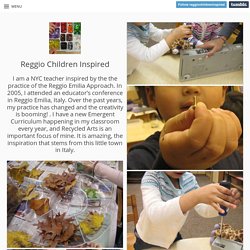
Recently, one of our Stickbugs died…and this conversation happened. This is why I love teaching. OH! OH! OH! O-CANADA IDEAS!! Oh, my goodness!

Did I LOVE those teachers in Canada!!! What an awesome two days! Hope you’ll enjoy reading ideas from our “show and share” over the next few days! Kinderoos, Kindies, and Chikcadees Aren’t these cute names for our little ones? Magic Carpet Ride (Navtej Mand) Pretend to go on a magic carpet ride. Thinking About Thinking. Kindergarten GAINS Home. Francophones_manual - school_readiness_english_fnl.pdf. Best Start - Resources. The Home of Forest Schools International - Information, training and resources. Motessori School House. Ø OUR CURRICULUM meets or even betters the curriculum set by the Ontario Ministry of Education and Training.
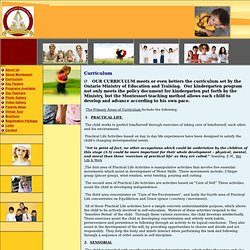
Our kindergarten program not only meets the policy document for kindergarten put forth by the Ministry, but the Montessori teaching method allows each child to develop and advance according to his own pace. The Primary Areas of Curriculum Include the following; The child works to perfect him/herself through exercises of taking care of him/herself, each other and his environment. Practical Life Activities based on day to day life experiences have been designed to satisfy the child’s changing developmental needs. “Yet in point of fact, no other occupations which could be undertaken by the children of this stage (3-5) could be more important for their whole development – physical, mental, and moral than these ‘exercises of practical life’ as they are called.” A phonetic approach to language development. Include biology, general science, geography, history, art and music. Trash For Teaching. Waste Not Center. What Are Open-Ended Materials?
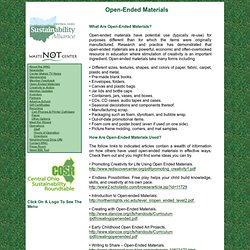
Open-ended materials have potential use (typically re-use) for purposes different than for which the items were originally manufactured. Research and practice has demonstrated that open-ended materials are a powerful, economic and often-overlooked resource in education where stimulation of creativity is an important ingredient. Open-ended materials take many forms including • Different sizes, textures, shapes, and colors of paper, fabric, carpet, plastic and metal. • Pre-made blank books. • Envelopes, folders. Above ground Art Supply Store. Membership. Membership in the National Association for the Education of Young Children (NAEYC) is the best way for you to access all of the resources you need to help you be the best educator you can be.
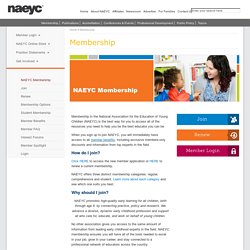
When you sign up to join NAEYC, you will immediately have access to all member benefits, including exclusive members-only discounts and information from top experts in the field. How do I join? Click HERE to access the new member application or HERE to renew a current membership. NAEYC offers three distinct membership categories: regular, comprehensive and student. Learn more about each category and see which one suits you best. Why should I join? NAEYC promotes high-quality early learning for all children, birth through age 8, by connecting practice, policy and research. No other association gives you access to the same amount of information from leading early childhood experts in the field. Visuals. The Power of Play. There has been an abundance of research around play and its positive effects on early childhood learning and development.
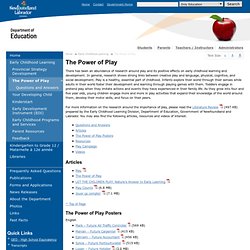
In general, research shows strong links between creative play and language, physical, cognitive, and social development. Play is a healthy, essential part of childhood. Infants explore their world through their senses while adults in their world foster their development and learning through playing games with them. Toddlers engage in pretend play when they imitate actions and events they have experienced in their family life. As they grow into four and five year olds, young children engage more and more in play activities that expand their knowledge of the world around them, develop their motor skills, and focus on their peers. For more information on the research around the importance of play, please read the Literature Review (497 KB) prepared by the Early Childhood Learning Division, Department of Education, Government of Newfoundland and Labrador.
Articles English. Alliance for Childhood. Playing to Learn. A review of A New Culture of Learning: Cultivating the Imagination for a World of Constant Change by Douglas Thomas and John Seely Brown, 2011.
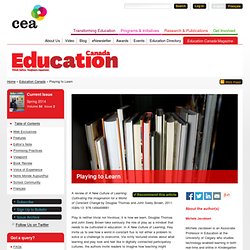
ISBN-13: 978-1456458881 Play is neither trivial nor frivolous; it is how we learn. PLAY=LEARNING - PlayfulLearningKeynote.pdf. The Role of Play in the Overly-Academic Classroom. Hand in Hand Strategies to support play-based learning. Playing to Learn. Playing to Learn Curriculum - Y Kids. YMCAs of Cambridge & Kitchener-Waterloo YMCA child care is an exciting and challenging place, helping children stretch their skills in mind and body.
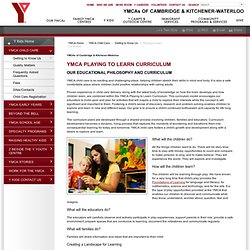
It is also a safe comfortable place where children build positive relationships with caring adults. Proven experience in child care delivery, along with the latest body of knowledge on how the brain develops and how children learn, are combined within the YMCA Playing to Learn Curriculum. This curriculum model encourages our educators to build upon and plan for activities that will inspire a child to explore their interests while the concept is still significant and important to them.